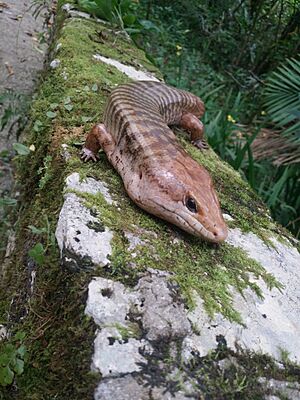Haitian giant galliwasp facts for kids
Quick facts for kids Caribicus warreni |
|
|---|---|
 |
|
| Adult male in Dominican Republic | |
| Conservation status | |
| Scientific classification | |
| Genus: |
Caribicus
|
| Species: |
warreni
|
| Synonyms | |
|
|
The Haitian giant galliwasp or Hispaniolan giant galliwasp is a special kind of lizard. Its scientific name is Caribicus warreni. This lizard belongs to a group of reptiles called Diploglossidae. It lives only on the island of Hispaniola. This means it is an endemic species.
Contents
About the Haitian Giant Galliwasp
This section tells you more about this interesting lizard.
What's in a Name?
The scientific name for this lizard is warreni. This name was chosen to honor a person named Mr. C. Rhea Warren. He was a scientist who collected many reptile specimens. He found some of these specimens on Île de la Tortue, which is an island near Haiti.
Where Do They Live?
C. warreni can be found in two countries. These are the Dominican Republic and Haiti. Both countries are on the island of Hispaniola.
What Do They Look Like?
The Haitian giant galliwasp is a very large lizard. It can weigh around 68 grams (about 2.4 ounces). This makes it one of the bigger lizards in its family.
Where Is Their Home?
These lizards like to live in Hispaniolan moist forests. They often hide under piles of fallen leaves. They also like to hide under other natural things found on the forest floor. This helps them stay safe and cool.
What Do They Eat?
The giant Hispaniolan galliwasp is a hunter. It eats many different things. Its diet includes insects and earthworms. It also hunts small mammals and other reptiles. It will eat whatever food it can find.
Protecting the Haitian Giant Galliwasp
This lizard faces several dangers. People are working to protect it.
Why Are They in Danger?
The Haitian giant galliwasp is considered a vulnerable species. This means it is at risk of disappearing. Here are some of the main reasons why:
- Loss of Home: Their natural habitat is shrinking. Forests are being cut down for other uses.
- New Predators: Animals that are not native to the island can be a problem. For example, the small Indian mongoose hunts these lizards.
- Illegal Pet Trade: Some people try to catch these lizards to sell them as pets. This is against the law.
- Misunderstanding: Many local people wrongly believe these lizards are venomous. Because of this, they often kill the galliwasps when they see them. This is a big problem for the lizards.


